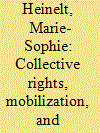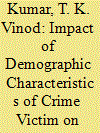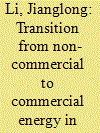| Srl | Item |
| 1 |
ID:
142487


|
|
|
|
|
| Summary/Abstract |
This article outlines a comparative perspective on legal multiculturalism in Latin America. It analyzes how consultation and territorial autonomy rights may be used to include the interests of indigenous and afro-descendant minorities in decision making. It is argued that (a) the organizational forms of minorities and (b) previous patterns of interaction with state actors need to be taken into account systematically. Scrutiny of two case studies from Colombia and Panama shows that collective rights can improve access to decision makers and help to channel minority interests into policy outputs. Both case studies reveal that confederal organizational forms help to maintain coherent ethnic mobilization. The Panamanian case furthermore demonstrates that previous interactions with state actors can result in bargaining advantages for minorities.
|
|
|
|
|
|
|
|
|
|
|
|
|
|
|
|
| 2 |
ID:
155176


|
|
|
|
|
| Summary/Abstract |
Demographic characteristics of crime victims have an impact on their interaction
with the police. The initial mindset of the victim before contact with the police
and post interaction assessment of satisfaction with police services are important
indicators of the social dynamics and functioning of the criminal justice system.
The first indicating individual perception of social location and accessibility to
police, and the latter the levels of professionalism in police response to victims
of crime. This study examines the influence of demographic characteristics on
the state of mind of victims when they approach police in India and further on
their assessment of police after the interaction, and on the basis of the findings
comments on the state of police services in India.
|
|
|
|
|
|
|
|
|
|
|
|
|
|
|
|
| 3 |
ID:
166323


|
|
|
|
|
| Summary/Abstract |
Rural components are integral parts of China's economy, and hundreds of millions of China's residents still live in rural areas. Rural residents heavily depend on non-commercial energy due to the inaccessibility and unaffordability of commercial energy. Conventional use of solid biomass fuels threatens public health as well as environmental and ecological sustainability. Thus, rural energy transition must be promoted. By using a new dataset, we show China's rural energy transition to gain insights on where, how, and why this transition occurs in rural households. Unlike previous views, we find that after considering non-commercial energy, the per capita consumption of rural residential energy is considerably larger than that of urban counterparts. Moreover, migrations from rural to urban areas decrease rather than increase residential energy consumption. Furthermore, rural energy transition from low to high quality depresses energy consumption. Our results demonstrate how accessibility and affordability affect the fuel preferences of rural residents, thereby enabling us to identify the mechanisms of rural energy transition. We provide some insights and policy implications on the routes of China's rural energy transition, which may be further extended to other emerging and developing countries due to their similar rural energy use.
|
|
|
|
|
|
|
|
|
|
|
|
|
|
|
|